
As a mid-range GPU the most affordable GTX 1060's from Nvidia partners are likely to attract the eye of PC Gamers looking to upgrade on a tight budget. Palit answers this call directly with a more price-aggressive alternative to ASUS, MSI and other brands with its JetStream GTX 1060s.

Palit offers a number of GTX 1060 options but its the stock-clocked JetStream and overclocked Super JetStream graphics cards that arguably deliver the best combination of cooling, features, value and performance. Notable inclusions are semi-passive fan operation, RGB lighting, a dual BIOS and uprated-quality “Turbo Fans” which are similar in nature to MSI's Torx Fan.
The Super JetStream has an overclock that matches the ASUS GTX 1060 STRIX OC, 1620MHz core and 1847 MHz boost, though the memory remains at stock which should give the ASUS GPU a slight performance edge. The baseline JetStream model retains stock Nvidia clock speeds but should have a higher average boost clock speed than the Founders Edition by averting thermal throttling.
Palit also has an entry-level GTX 1060 Dual that sacrifices some features of the JetStream (dual BIOS, RGB and up-rated fans) to target a lower price point.
The price point of all three Palit cards, including the GTX 1060 Super JetStream, is lower than Nvidia's GTX 1060 Founders Edition and equivalent offerings from ASUS, MSI and others. Palit also charges only a nominal price premium for the overclocked model over the stock model which should give other video card brands some food for thought.
Customers in North America won't be able to buy the Palit Super JetStream as Palit doesn't sell to the North American market, the company pulled out in 2009. Though many of the Palit Microsystems sub-brands, Gainward and Galaxy for example, still retain a strong presence.
| GPU | Nvidia GTX 1060 Founders Edition |
Palit GTX 1060 JetStream | Palit GTX 1060 Super JetStream |
| Base Clock | 1506 MHz | 1506 MHz | 1620 MHz |
| GPU Boost Clock | 1708 MHz | 1708 MHz | 1847 MHz |
| Memory Clock Effective |
8008 MHz | 8008 MHz | 8008 MHz |
| Memory Bandwidth | 192 GB/s | 192 GB/s | 192 GB/s |
| Price (£/$) | £275/$300 | £265 /$N/A | £270 / $N/A |
Palit's GTX 1060 Super JetStream comes neatly presented in a somewhat oversized package that hints at the company's Asian heritage. The product's key features are clearly demarcated on the rear.
The accessory bundle is typically limited for a high-end card, a user manual, driver and utility DVD and a dual Molex to single 6 pin power adapter.
The Palit GTX 1060 JetStream is slightly more bloated than usual, conforming to a 2.5-slot form factor rather than the 2-slot design of most other video cards in the same class. As the GTX 1060 doesn't support SLI this has no implications for multi-GPU compatibility, though smaller motherboards and cases may find space conflicts more likely.
Rear I/O connectivity is standard for the class with three DisplayPort 1.4, one HDMI 2.0 and a dual-link DVI. ASUS still has the lead in the I/O department by offering two HDMI 2.0 ports for VR users, although technically speaking three DisplayPort gives you much more flexibility.
Power is drawn in through a supplementary 6 pin connection, not an 8-pin as found on both the ASUS GTX 1060 STRIX OC and the MSI GTX 1060 Gaming X.
The 8 pin probably isn't needed as the 120-watt GTX 1060 is unlikely to exceed the 150W capability of the PCIe bus and 6 pin, even under peak overclocked loads. Yet a 30-watt margin is a little close for comfort, an 8pin would have been nice to see.
A backplate is fitted to the Palit GTX 1060 JetStream as standard which gives a quality finish that you'd expect for the price point.
The dual fans measure in at 90mm each and use angled fan blades which Palit are describing as “TurboFan Blades”. These fans are supposedly better optimised for creating static pressure to the heatsink beneath, these fans are also equipped with a fan-disable mode once the temperature and GPU load falls below a threshold.
The Palit software which allows for LED tweaking and GPU overclocking is called Thunder Master. The RGB options include a fixed range of colours for GPU temperature (a continuum of green to red), a rainbow effect or a still colour using any combination of 8 bit RGB colour codes (16.8 million options total).
On the whole the RGB options are basic and could do with more depth – e.g. more LED lighting patterns and an ability to reconfigure existing patterns. The overclocking utility is adequate but isn't as intuitive or rewarding to use as GPU overclocking mainstays like MSI Afterburner.
Our newest GPU test system has been built with the intention of benchmarking low to mid-range graphics cards, we have a separate test system which benchmarks higher-end graphics cards such as the RX 480, GTX 1070 and GTX 1080. To reflect the performance of GPUs being tested the scope of testing has been reduced to 1080p and 1440p, since 4K is largely irrelevant for GPUs of this price point.
General Test System Notes
- AMD Graphics cards were benchmarked with the AMD Crimson Display Driver 16.6.1, though the RX 480 was tested on 16.7.2 to rectify power issues with the PCI Express slot
- Nvidia Graphics cards with the Nvidia Forceware 368.39 driver except the newer Nvidia GTX 1060 GPUs which were tested using the 368.64 release driver
- To tune the test system appropriately for acoustic measurements the case was outfitted with ultra quiet Noctua 800RPM fans and the Corsair H100i set to a fixed fan speed of 700RPM to further reduce the base noise level.
- The CPU was left to default Intel Turbo behaviour, disabling motherboard manufacturer enhancements such as all-core Turbo to minimise heat output inside the case and non-GPU related power consumption.
- Each benchmark or game is run 3 times at each resolution with an average result of the three runs taken as the final result for the graphs. Where benchmark screenshots are shown note these may not match the graphed figure since an average of three is taken.
Test System Components
- Case: Corsair 400Q (two stock case fans replaced with Noctua 800 RPM 120mm rear exhaust and 140mm front intake fans)
- Processor: Intel Core i7-6700K (Stock Intel Turbo behaviour).
- Memory: 32GB (4 x 8GB) G.Skill Trident Z DDR4 running at JEDEC 2800MHz.
- Graphics Card: Variable.
- System Drive: Mushkin Chronos 120GB.
- Games Drive: Samsung 850 EVO 512GB SSD
- CPU Cooler: Corsair H100i w/ Noctua NTH1 (fan speed limited to 700 RPM on Corsair H100i).
- Power Supply: Seasonic Platinum 760W.
- Operating System: Windows 10 Pro 64-bit.
Comparison Graphics Cards List
- EVGA GTX 750 Ti 2GB Superclocked (1176MHz core, 1255MHz boost, 5400MHz memory )
- MSI R7 370 2GB Gaming (980MHz core, 1030MHz boost, 5600MHz memory)
- MSI R9 380 4GB Gaming (980MHz core, 5700MHz memory)
- MSI R9 390 8GB Gaming (1040MHz core, 6000MHz memory)
- PNY GTX 950 2GB XLR8 OC Gaming (1152MHz core, 1342MHz boost, 7200MHz memory)
- PNY GTX 960 4GB XLR8 OC Gaming (1203MHz core, 1266MHz boost, 7200MHz memory)
- Sapphire R9 380X 4GB Nitro OC (1040MHz core, 6000MHz memory)
- XFX R7 360 2GB Core Edition (1050MHz core, 6000MHz memory)
- Zotac GTX 970 4GB (1076MHz core, 1216MHz boost, 7010MHz memory)
- ASUS GTX 950-2G (1026MHz core, 1190MHz boost, 6612MHz memory)
- AMD RX 480 8GB (1266MHz core, 8000MHz memory)
- AMD RX 480 4GB (8GB card with 4GB vBIOS, 1266MHz core, 7000MHz memory)
- Nvidia GTX 1060 6GB Founders Edition (1506MHz core, 1708MHz boost, 8008MHz memory)
- Nvidia GTX 1070 8GB Founders Edition (1506MHz core, 1683MHz boost, 8008MHz memory)
- ASUS GTX 1060 6GB STRIX OC (1620MHz core, 1847MHz boost, 8208MHz memory)
- MSI GTX 1060 6GB Gaming X (1569MHz core, 1784MHz boost, 8008MHz memory)
- Palit GTX 1060 6GB Super JetStream (1620MHz core, 1847MHz boost, 8008MHz memory)
Software and Games List
- 3DMark
- Ashes of the Singularity
- Furmark
- GPU-Z
- Grand Theft Auto V
- Metro Last Light Redux
- Middle-earth: Shadow of Mordor
- MSI Afterburner
- Rise of the Tomb Raider
- Steam
- Unigine Valley

The Steam VR score delivered by the Palit GTX 1060 is good enough for a “very high” experience on average. The GTX 1070 and GTX 1080 are both a considerable amount faster, but on a budget the GTX 1060 offers a sound level of performance.
3DMark Fire Strike is a showcase DirectX 11 benchmark designed for today's high-performance gaming PCs. It is our most ambitious and technical benchmark ever, featuring real-time graphics rendered with detail and complexity far beyond what is found in other benchmarks and games today.


3DMark gives a reliable representation of how the Palit GTX 1060 Super JetStream fares relative to the competition – It's about 5% faster than the Founders Edition and falls between the MSI GTX 1060 Gaming X and ASUS GTX 1060 STRIX OC.
UNIGINE Valley Benchmark is a new GPU stress-testing tool from the developers of the very popular and highly acclaimed Heaven Benchmark. The forest-covered valley surrounded by vast mountains amazes with its scale from a bird’s-eye view and is extremely detailed down to every leaf and flower petal.
This non-synthetic benchmark powered by the state-of-the art UNIGINE Engine showcases a comprehensive set of cutting-edge graphics technologies with a dynamic environment and fully interactive modes available to the end user.
We test Unigine Valley using the Extreme HD Preset, changing the resolution setting only for 1440p.
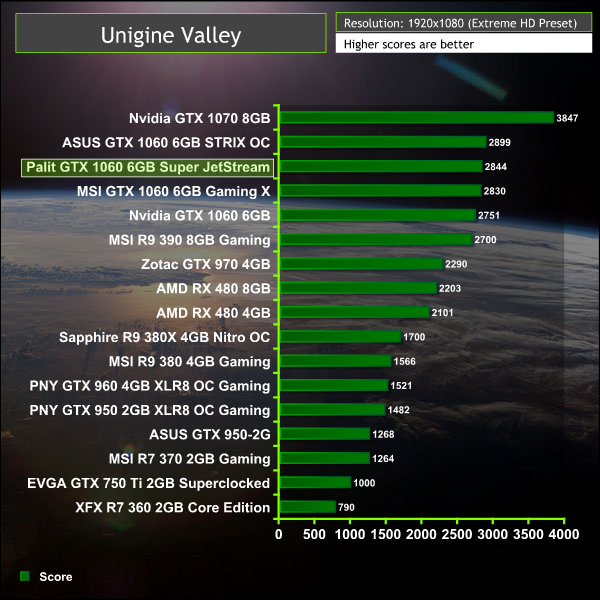

In Unigine Valley the Palit card also falls between the ASUS and MSI equivalents.
Ashes of the Singularity is a real-time strategy game set in the future where descendants of humans (called Post- Humans) and a powerful artificial intelligence (called the Substrate) fight a war for control of a resource known as Turinium.
Players will engage in massive-scale land/air battles by commanding entire armies of their own design. Each game takes place on one area of a planet, with each player starting with a home base (known as a Nexus) and a single construction unit.


There's virtually nothing to separate all the GTX 1060s we tested in Ashes of the Singularity.
Grand Theft Auto V is an action-adventure game played from either a first-person or third-person view. Players complete missions—linear scenarios with set objectives—to progress through the story. Outside of missions, players may freely roam the open world. Composed of the San Andreas open countryside area and the fictional city of Los Santos, the world is much larger in area than earlier entries in the series. It may be fully explored after the game’s beginning without restriction, although story progress unlocks more gameplay content.
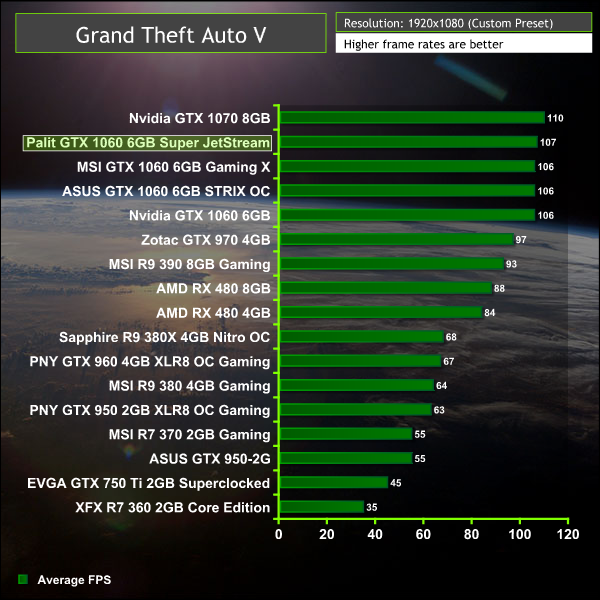

While clock speeds may vary between aftermarket GTX 1060s, because of the Nvidia Boosting algorithm most GTX 1060s end up performing within a frame or two of each other.
Just like the original game Metro 2033, Metro: Last Light is played from the perspective of Artyom, the player-character. The story takes place in post-apocalyptic Moscow, mostly inside the metro system, but occasionally missions bring the player above ground. Metro: Last Light takes place one year after the events of Metro 2033, following the canonical ending in which Artyom chose to proceed with the missile strike against the Dark Ones (this happens regardless of your actions in the first game). Redux adds all the DLC and graphical improvements.


Metro Last Light shows the MSI and Palit GTX 1060s as being neck-and-neck, to the nearest frame.
Middle-earth: Shadow of Mordor is a third-person open world video game, where the player controls a ranger by the name of Talion who seeks revenge on the forces of Sauron after his family, including his wife, are killed. Players can travel across locations in the game through parkour, riding monsters, or accessing Forge Towers, which serve as fast travel points.


Strangely, MSI's GTX 1060 does better in Middle-earth: Shadow of Mordor despite being clocked slightly lower. There's clearly some benchmark variability at play here.
Rise of the Tomb Raider is a third-person action-adventure game that features similar gameplay found in 2013’s Tomb Raider. Players control Lara Croft through various environments, battling enemies, and completing puzzle platforming sections, while using improvised weapons and gadgets in order to progress through the story. It uses a Direct X 12 capable engine.


In Tomb Raider there's, yet again, little than a few frames to separate all the GTX 1060s on test.
Our acoustic measurements are less precise on this mid-range test system, the noise floor of the totally quiet testing room is 35 dBA as measured with a Benetech GM1351 Digital Sound Level Meter.
We take our measurements with the decibel meter protruding off the front-top section of the chassis, overhanging by exactly 1 inch. The underlying noise level of the system, generated by the 800 RPM Noctua case fans and H100i with fixed 700RPM fans is 39 dBA, thus anything above this level can be attributed to the graphics card since the PSU is passive for most of it's power capability.
Noise levels were measured after 10 minutes of load under three scenarios: Furmark GPU stress test, Unigine Valley looping at the Extreme HD preset and desktop idle.

Acoustic performance was excellent and matched the MSI GTX 1060 Gaming X, despite being clocked higher. Fan speeds were around 1200 RPM (50%) under heavy gaming loads which is totally inaudible for the 90mm fans used. If we're being picky the MSI card is still the better cooler since it operates at lower RPMs under heavy load (around 900) on its slightly larger fans and exhibits lower temperatures.
At idle the fans turn off and enter into a passive state, producing no noise.
Temperatures were measured after 10 minutes of load under three scenarios: Furmark GPU stress test, Unigine Valley looping at the Extreme HD preset and desktop idle. GPU-Z was used to record the maximum temperature, fan profiles were left to their default behaviour.
Delta temperatures are presented below to account for small fluctuations in room temperature, but for all the testing present in this graph the temperature ranged from 21.4 to 23.5 degrees Celsius.

Delta temperatures of about 50 degree meaning low 70s in a typical room of 20-25 degrees Celsius.
These are good temperatures that mean thermal throttling will never occur, though the Palit card is about 8-12 degrees hotter than the competition. Palit has traded some thermal headroom in order to keep noise down which has definitely paid off.

The backplate helps keep peak temperatures on the outside of the card sub-60 degrees Celsius.
Power consumption was measured after 10 minutes of load under three scenarios: Furmark GPU stress test, Unigine Valley looping at the Extreme HD preset and desktop idle. The measurement was taking using an Energenie ENER007 power meter and measured for the whole system, excluding the monitor.
While Furmark and desktop idle provide stable and consistent power read-outs, Unigine Valley does not so the power reading is taken as the highest value in Scene 1 of 18.
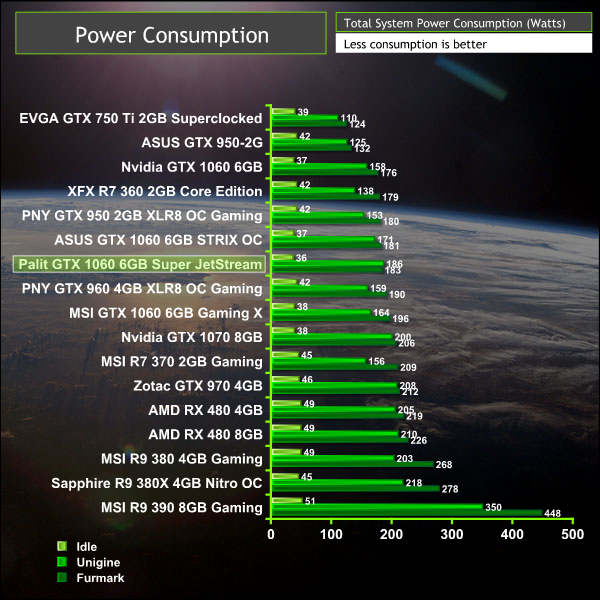
Power consumption aligns closely with the ASUS card which you might expect given the similar core clock speeds. The ASUS card consumes a little less, 10-15 watts, suggesting it has some power efficiency savings where the Palit card doesn't – most likely with fan or VRM efficiency.
Overclocking seems to be highly similar between all variations of GTX 1060 we've tested so the Palit's results were unsurprising, here's how our test samples have fared:
- Palit GTX 1060 Super JetStream (Core: 1670 MHz, Memory: 2352 MHz)
- MSI GTX 1060 Gaming X (Core: 1679 MHz, Memory: 2302 MHz)
- ASUS GTX 1060 STRIX OC (Core: 1690 MHz, Memory: 2302 MHz)
- Nvidia GTX 1060 Founders Edition (Core: 1681 MHz, Memory: 2302 MHz)

The real-world performance gain is up to 10% depending on the game or application.
Palit's GTX 1060 Super Jetstream is yet another attractive makeover for Nvidia's latest mid-range Pascal GPU. Palit may not be the most prestigious or well-marketed name in the world of VGA (even if its parent company often ships the most units) but its JetStream has the credentials worthy of serious consideration.
Our analysis shows the Palit GTX 1060 only loses out to the competition in a couple of minor ways – a slightly bloated 2.5 slot design and higher temperatures which are typically in the low 70s for gaming.
The 2.5 slot design only becomes problematic in compact cases or systems, or when the user has many PCIe expansion cards. Multi-GPU compatibility is a non-issue since the Nvidia GTX 1060 has no SLI support. Temperatures remain good enough to facilitate the maximum boost speed and allow the fans to operate quietly.
Therefore, in practice, neither of these are significant issues and Palit's competitive pricing far outweighs these niggles.

On the subject of pricing Palit does well to stand out in a competitive market, offering a notable saving against established players like ASUS and MSI. The base JetStream model is around £265 while overclocked Super JetStream variant is £270. In context ASUS currently charges £300/320 for its GTX 1060 STRIX and STRIX OC, MSI charges £290/300 for its Gaming and Gaming X GTX 1060.
While all pricing can vary by region, retailer and is subject to change, Palit is clearly more aggressive on price which is important for this market segment. When £20 to £30 is the difference between a better CPU, motherboard or more system memory, the Palit GTX 1060 JetStream is a convincing option.
It's also important to stress no feature-level compromises are made versus the competition either to cut these costs. Palit are still able to deliver a full backplate, RGB functionality with its companion software and a semi-passive fan mode.
The only obvious cost-saving measure is in the fact the standard warranty period is only 2 years. Many other vendors adhere to a similar 2 year warranty duration but, importantly for prospective buyers, the likes of ASUS, EVGA and MSI, among a few others, all deliver 3 year standard warranties.
Discuss on our Facebook page, over HERE.

Buy from Overclockers UK for £269.99 inc vat HERE.
Pros
- Quiet operation with reasonable temperatures
- Highly competitive pricing, modest premium for OC model
- Good feature-set
Cons:
- 2.5 slot design
- No memory overclock
- 2 year UK warranty
- RGB software is basic
KitGuru says: Affordable, attractive and well imbued with features, the Palit GTX 1060 Super JetStream is an excellent alternative to pricier rivals.
 KitGuru KitGuru.net – Tech News | Hardware News | Hardware Reviews | IOS | Mobile | Gaming | Graphics Cards
KitGuru KitGuru.net – Tech News | Hardware News | Hardware Reviews | IOS | Mobile | Gaming | Graphics Cards












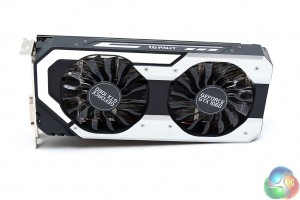







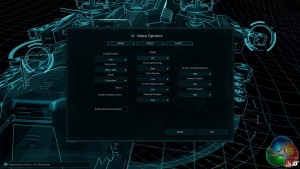
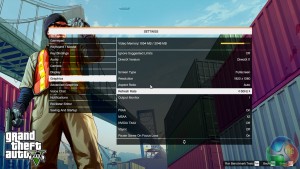




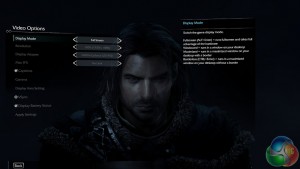





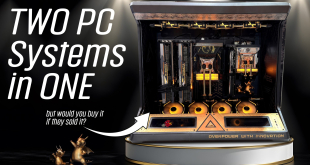
great review
Superb.